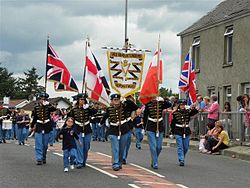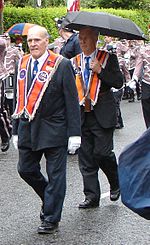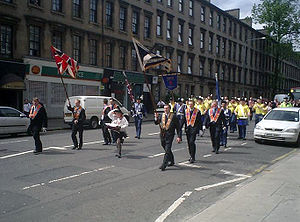- Orange walk
-
 Orangemen marching in Bangor on 12 July 2010
Orangemen marching in Bangor on 12 July 2010
Orange walks are a series of parades held annually by members of the Orange Order during the summer in Northern Ireland, to a lesser extent in Scotland, and occasionally in England, the Republic of Ireland, and throughout the Commonwealth. These typically build up to the 12 July celebrations which mark Prince William of Orange's victory over King James II at the Battle of the Boyne in 1690. Although the term 'march' or 'parade' is widely used in the media, the Order prefers terms such as 'walk' or 'demonstration'.
Contents
The 'marching season'
 Battlehill LOL 395 marching in Tandragee on 12 July 2008
Battlehill LOL 395 marching in Tandragee on 12 July 2008
The 'marching season' generally refers to the months April to August in Northern Ireland and includes marches by groups such as the Ancient Order of Hibernians, the Apprentice Boys of Derry, and the Royal Black Institution as well as the Orange Order. The Orange Order however, is by far the most prolific marching group. Typically each Orange Lodge will hold its own march at some point before the 12th of July, accompanied by at least one marching band. On the 12th of July each district will hold a larger parade consisting of all the lodges in that district, sometimes with the addition of lodges from outside Northern Ireland. This is particularly the case with the Belfast district, whose parade commonly features several Scottish lodges and often some from other countries. In most districts the location of the parade will vary from year to year, rotating around suitable towns. Belfast is an exception, keeping more or less the same route for many decades. The only major parade after the Twelfth is on the last Sunday in October, when lodges celebrate Reformation Day by parading to church.
Some walks commemorate historic events; most notably, the 12th of July marches remember the Battle of the Boyne. A number of marches all over Northern Ireland on and around the 1st of July originally commemorated the participation of the 36th (Ulster) Division in the Battle of the Somme. However since the beginning of the Troubles most of these parades have evolved into the 'mini Twelfth', and have little obvious connection with World War I. However there are still a few explicitly commemorative parades.[1] Reformation Day parades are held in honour of Martin Luther nailing his 95 theses to the church door in Wittenberg, thus starting the Reformation which brought about the Protestant churches.
Form of parades
All Orange walks include at least one lodge, with officers. The lodge will almost always be accompanied by a marching band, often a flute band but other parading band types include fife and drum, silver, brass and accordion. Walks may include dozens of lodges for major events such as the Twelfth, down to one lodge only. Elderly or infirm lodge members often travel the parade route in a vehicle such as a black taxi. It has become much more common in recent decades for members of Ladies' lodges to walk, although women are still massively outnumbered by men in most parades. Larger walks, especially on the Twelfth, may be headed by a figure on a white horse dressed as Boyne victor William of Orange. A few parades also include others in historical fancy dress or, more rarely, a float such as that constructed for the 1990 Twelfth celebrations. This represented the Mountjoy, the ship which lifted the Siege of Derry.
Regalia and accessories
Parading Orangemen usually wear dark suits, although in particularly warm weather they may dispense with the jacket. Some Orangemen wear Bowler hats and walk with umbrellas. Although this does add a bit of class and good fun, it is not mandatory for Orangemen to do so. Walkers will wear V-shaped orange collarettes (often inaccurately known as sashes) bearing the number of their lodge and often badges showing degrees awarded within the institution, and positions held in the lodge. Some lodge officers also wear elaborate cuffs, and many walkers wear white gloves, although this is less common than it used to be. Most lodges carry at least one flag, of which the most common is the Union Flag. Other commonly carried flags include the Ulster Banner, the Flag of Scotland and the Orange Order flag. Lodges will generally also carry a banner, which will include the name and number of the lodge, and usually depicts William of Orange on at least one side. Other popular banner subjects include deceased lodge members, local landmarks, and the Bible with a Crown.
 The "Red Hand Defenders" flute band marching with the Orange Order in Newtownstewart on 12 July 2010. The flags being carried are the Union Flag, Ulster Banner and Boyne Standard
The "Red Hand Defenders" flute band marching with the Orange Order in Newtownstewart on 12 July 2010. The flags being carried are the Union Flag, Ulster Banner and Boyne Standard
Bands
Typically there will be one band per lodge. In some cases the band will have a formal connection with the lodge but in most cases it will simply be hired for the day. Bands and lodges pair up by word of mouth, through the band or lodge advertising in a Protestant publication such as the Orange Standard, or as a result of a lodge member hearing the CDs and tapes which many bands produce. Most bands have a strongly Protestant ethos and display bannerettes and flags associated with loyalism and in some cases paramilitary groups. Many are associated with or named after particular Protestant areas such as the Shankill Road in Belfast, although the number of 'Shankill Road' bands suggest that many of their members are from elsewhere. In 1985, concerned that the behaviour of some bands was bringing the Order into disrepute, the Grand Orange Lodge instituted a system of band contracts, in which bands make a commitment that they will not misbehave. According to writer and former Orangeman Brian Kennaway, the contracts have been largely ineffective, mostly because of the Order's reluctance to adequately enforce them.[2]
Controversy
 A loyalist mural supporting the Portadown Orangemen in the Drumcree parade dispute
A loyalist mural supporting the Portadown Orangemen in the Drumcree parade dispute
Throughout the history of the Orange Order, Orange walks have faced opposition, generally from Catholics and nationalists, who feel that the parades are sectarian and triumphalist. Although many nationalists find the parades offensive wherever they take place, conflict usually only arises when a walk passes through or near a Catholic-dominated area. During The Troubles many marchers were verbally abused, had things thrown at them or, less commonly, were shot at.[citation needed] The marching season required high levels of police involvement to prevent major outbreaks of violence, and as a result parading was banned in the region on several occasions in the early 1970s, although the ban was never in place on the 12th of July.[3]
Currently, of the more than 2000 annual parades in Northern Ireland, only a handful are considered contentious. The best known of these is the Drumcree conflict. The Drumcree area, near Portadown has a history of parading disputes going back to the nineteenth century, and the current dispute centres on the refusal of the Parades Commission to allow the Portadown lodge through the Catholic Garvaghy Road during their annual celebrations in early July.[1] The conflict led to severe rioting in the late 1990s, but the area has been relatively calm in recent years.
Parade opponents in Drumcree and elsewhere put forward several arguments against the parades: that they are sectarian regardless of their route, as they celebrate the defeat of Irish Catholicism; that when they go through Catholic areas this is particularly insulting and triumphalist; and that regardless of their content they cause serious inconvenience to residents as roads must be closed and, in particularly contentious areas, access to the roads denied. One observer has argued that the Orange Institution and its numerous demonstrations of strength effectively deny Nationalists and Catholics their basic human rights[4] The Orange Order and its supporters counter that the parades are not sectarian and that any sectarian activity and violence is perpetuated by outsiders and 'hangers-on' who the Order has no control over; that inconvenience is mostly caused by the need for police to protect marchers from the violence of their opponents; and that the disputes are not actually about parading at all but are a way for republicans to attack Protestantism. They also argue that there is a fundamental 'right to march' and that any group should be able to walk down 'the Queen's highway' without interference. In practice, however, the Order has tended to oppose marches by republicans and other 'disloyal' groups on the grounds that there is no right to parade sedition. The Order has a policy of non-negotiation with residents' groups as it believes that these are dominated by Sinn Féin and do not represent the actual opinions of residents.[5]
Accusations of sectarianism have also been levelled against Orange walks, and the Order in general, in Scotland.
Walks outside Northern Ireland
Orange walks were once common throughout the island of Ireland, especially on the 12th of July. However, since partition those in the Republic of Ireland have dwindled in number, partly because of local antagonism and partly because of the decline in the Protestant population of the Republic. The last walk in Dublin was in 1937 and the only remaining walk in the Republic takes place at Rossnowlagh, County Donegal, near the border with Northern Ireland.
Orange walks continue in in Scotland, across the country, but overwhelmingly concentrated in Glasgow, Lanarkshire, Ayrshire, Renfrewshire and West Lothian.[6] The walks have on occasion been associated with sectarian behaviour on the part of spectators.[7]
The parades have been more broadly criticised as an incitement to violence and hatred.[8] However the Grand Orange Lodge of Scotland has supported police moves to fine spectators for sectarian activity,[9] with Grand Master Ian Wilson saying that "all the effort that has gone into defending our interests can be destroyed by the stupidity of the few".[8]
Marches were common in Australia at the turn of the 20th century, the Kalgoorlie and Boulder marches in 1890s and 1900s attracting conflict between Catholics and Protestant marchers. In New Zealand they continued until at least the 1920s, but no longer take place.[10]
Orange Walks on the 12th of July were once large public occasions in Canada, particularly in the provinces of Ontario and Newfoundland that have a strong Loyalist heritage. In recent decades turnout has dwindled, although some parades in Canada do continue.
Orange Walks also exist in England, particularly in Liverpool.[11]
Notes
- ^ Helen Robinson, 'Remembering War in the Midst of Conflict: First World War Commemorations in the Northern Irish Troubles', 20th Century British History, 21, 1 92010), pp86-7.
- ^ Brian Kennaway, The Orange Order: A Tradition Betrayed, London, 2006, pp.73-4.
- ^ ‘Future policy on processions etc., First Report of the Joint Working Party on Processions etc. (Final Draft)’, December 1970, p.9, HA/32/2/39, Public Records Office of Northern Ireland.
- ^ Mulholland P. (1999) Drumcree: A Struggle for Recognition. Irish Journal of Sociology Vol. 9
- ^ Orange Order press release.
- ^ http://www.scotland.gov.uk/Publications/2005/01/20583/50704
- ^ http://www.bbc.co.uk/news/uk-scotland-glasgow-west-13993505
- ^ a b Tolmie, Andrew (2005-06-26). "Bigots hijack Orange parade". Sunday Mirror. http://findarticles.com/p/articles/mi_qn4161/is_20050626/ai_n14696967/. Retrieved 2010-03-10.
- ^ "Warning to bigots over Orange Walk behaviour". Evening Times. 2008-07-04. http://www.eveningtimes.co.uk/news/display.var.2378907.0.warning_to_bigots_over_orange_walk_behaviour.php. Retrieved 2010-03-10.
- ^ Ruth Dudley Edwards, The Faithful Tribe: An Intimate Portrait of the Loyal Institutions, London, 2000, p.136.
- ^ http://www.liverpoolecho.co.uk/videos-pictures/pictures-of-liverpool/pictures-of-liverpool-news/2008/05/12/orange-order-s-capital-of-culture-parade-100252-20899171/
Categories:- Orange Order
- Parades
Wikimedia Foundation. 2010.


